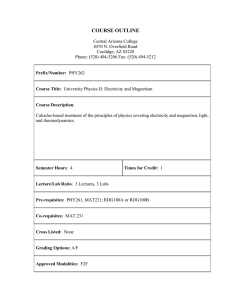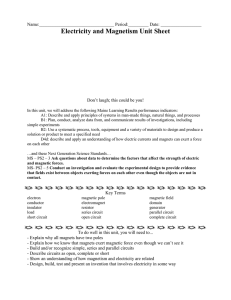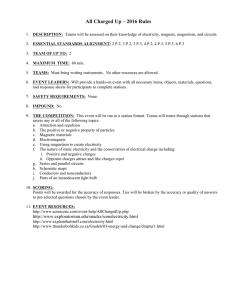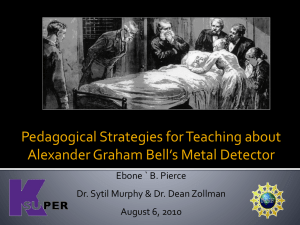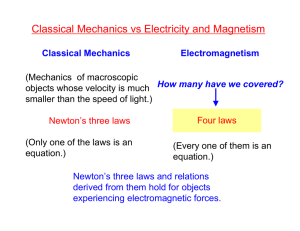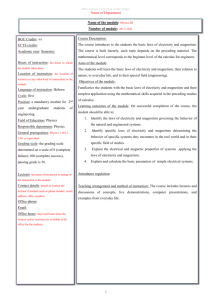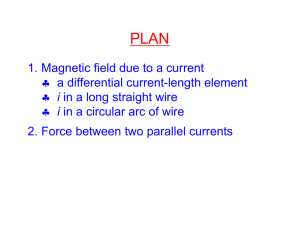Document
advertisement
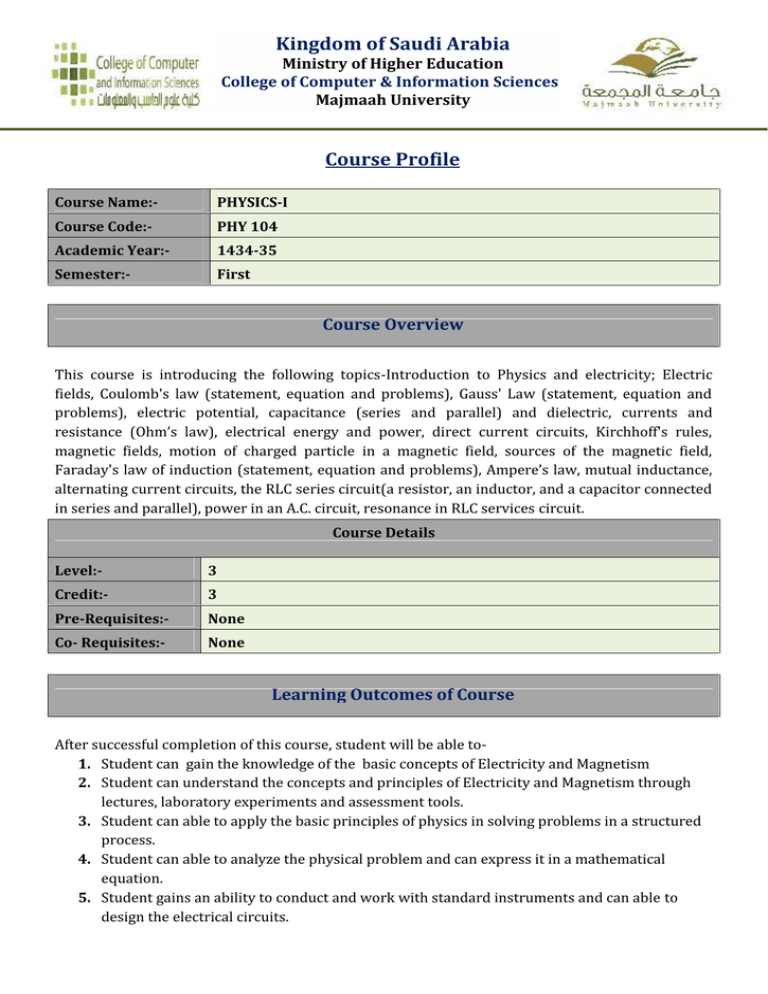
Kingdom of Saudi Arabia Ministry of Higher Education College of Computer & Information Sciences Majmaah University Course Profile Course Name:- PHYSICS-I Course Code:- PHY104 Academic Year:- 1434-35 Semester:- First Course Overview This course is introducing the following topics-Introduction to Physics and electricity; Electric fields, Coulomb's law (statement, equation and problems), Gauss' Law (statement, equation and problems), electric potential, capacitance (series and parallel) and dielectric, currents and resistance (Ohm’s law), electrical energy and power, direct current circuits, Kirchhoff's rules, magnetic fields, motion of charged particle in a magnetic field, sources of the magnetic field, Faraday's law of induction (statement, equation and problems), Ampere’s law, mutual inductance, alternating current circuits, the RLC series circuit(a resistor, an inductor, and a capacitor connected in series and parallel), power in an A.C. circuit, resonance in RLC services circuit. Course Details Level:- 3 Credit:- 3 Pre-Requisites:- None Co- Requisites:- None Learning Outcomes of Course After successful completion of this course, student will be able to1. Student can gain the knowledge of the basic concepts of Electricity and Magnetism 2. Student can understand the concepts and principles of Electricity and Magnetism through lectures, laboratory experiments and assessment tools. 3. Student can able to apply the basic principles of physics in solving problems in a structured process. 4. Student can able to analyze the physical problem and can express it in a mathematical equation. 5. Student gains an ability to conduct and work with standard instruments and can able to design the electrical circuits. Course Assessment Name of Assessment Task 1. Midterm Exam-1 2. Midterm Exam-2 3. Quizzes/ Assignments/ Seminar 4. Lab 5. Final Exam Weight of Assessment Week Due 15% 7th week 15% 12th week 10% 2,4,6,8,11 20% 15 40% Schedule by exam committee Assessment Task and Learning Outcomes Alignment Course Learning Outcomes Assessment Task Name 1. Midterm Exam-1 2. Midterm Exam-2 3. Quizzes 4. Assignments/Report/Seminar 5. Final Exam 1 2 3 √ √ √ √ √ √ √ √ √ √ √ √ √ √ √ Teaching Contact Details Name of Course Coordinator:- Dr.D.Baba basha Email of Course Coordinator:- b.dudekula@mu.edu.sa Lab/Tutorial Instructor:- Dr.D.Baba basha Email of Lab/Tutorial Instructor:- b.dudekula@mu.edu.sa Office Hours:- Wed10AMto12Noon Office Number:- 024-1-18-1 Office Phone Number:- 5386 4 5 √ √ √ √ Details of Required Text Book Book Name Authors Name Publisher Physics for Scientists and engineers Raymond A. Thomson Serway, John W. Brooks/ Cole Jewett Cengage Learning Year Edition 2013 9th Edition Year Edition Details of Required Reference Books Book Name 1. Fundamental of Physics Authors Name Publisher HALLIDAY / John Wiley & 2011 RESNICK / Sons, Inc. JEARL WALKER 9th Edition 2. Engineering physics R K GAUR S L GUPTA 2001 8th Revised Edition 3. Physics for Scientists &Engineers”,Vol.1 Douglas Giancoli 2007 4th Edition DHANPAT RAI PUBLICATIO NS C. AddisonWesley IT Resources The following IT Resources will require to access1. Majma’ah University Faculty Email 2. Faculty Web Page 3. Projector 4. http://science.pppst.com/physics.html 5. http://physwiki.ucdavis.edu 6. http://www.physics.org 7. http://www.physicsclassroom.com/ 8. http://www.phys4arab.net/ Course Schedule Course Topics Introduction to Electricity and magnetism Book’s Chapter Electric fields Electric flux, Gauss's Law (statement, Gauss’s Law equation and problems) Electric Potential and potential Electric Event Name Week Due Brain Week-1 storming and review of previous knowledge. Week-2 Quiz1 Week-3 difference, potential difference in a uniform Electric field Solving problems potential Definition of Capacitance, calculation of capacitance, combinations of capacitors, capacitors with dielectrics Capacitance and Assignment 1 dielectrics Electric current, Resistance, ohms law, Electric power and electrical energy Week-4 Electric Potential Applications Currents resistance Week-5 Written Week-6 Assessment Due Sunday (16 March 2014) 10:00PM Week-7 and First Midterm Test Electromotive force, Resistors in Direct current series and parallel, Kirchhoff’s Rules circuits Magnetic fields and forces, Motion of Magnetic fields charged particle in a magnetic field, The Biot-Savart Law, Amperes Law Sources of Quiz2 magnetic field Written Assessment Due Sunday(20 April2014) 10:00AM Week-8 Faraday’s Law of induction(statement, Faraday’s law equation and problems), Week-12 Self-induction and inductance,RL Inductance circuits, Mutual inductance, RLC Circuit The RLC series circuit (a resistor, an Alternating inductor, and a capacitor connected in current circuits series and parallel), power in an A.C. circuit, resonance in RLC services circuit. Review of the syllabus Final Examination Referencing Style Second Midterm Test Assignment 2 Week-9 Week-10 Week-11 Week-13 Week-14 Week-15 Exam Week The American Psychological Association (APA ) referencing style must be use for all submissions of this course. Course Assessment Task Assessment Name:Description of Task Assessment:- Midterm Exam-1 1. This assignment is aligned to learning outcomes 1, 2, 3 and 5. In that regard, the assignment contains questions that assess: The student knowledge on the basic concepts and principles of physics in particular electricity and Magnetism. 2. Students should be familiar with Coulomb’s law and they should be able to calculate forces between static charges 3. They should understand the concept of the electric field and they should be able to calculate electric fields from given charge distributions. 4. Students should understand the physical information contained in Gauss’s law and they should be able to apply this law to the calculation of field distributions in systems with specified symmetry. 5. They should be able to calculate the work done when a charge is moved in an electric field and connection that this has with electrostatic potential. 6. Students should be able to find the electric field for a system when the electrostatic potential is specified. 7. Students should be familiar with the concept of a capacitor and its capacitance. 8. They should understand the idea of regarding an electric field as containing energy. They should be able to calculate that electrical energy and power of electrical circuits in simple cases The complete details of the assessment task are Task Assessment Due Week/Date:Return Week/Date to Students:Weight of Task Assessment:List of Learning Outcomes Assessed:- provided in Module. 7th Week 8th Week 15% 1. Gain the knowledge of the basic concepts of Electricity and Magnetism 2. Understand the concepts and principles of Electricity and Magnetism through lectures, laboratory experiments and assessment tools. 3. Apply the basic principles of physics in solving problems in a structured process. Assessment Name:Description of Task Assessment:- 5. Gains an ability to conduct and work with standard instruments and can able to design the electrical circuits. Midterm Exam-2 1. This assignment is aligned to learning outcomes 1, 2, 3, 4 and 5. In that regard, the assignment contains questions that assess: The student knowledge on the basic concepts and principles of physics in particular electricity and Magnetism. 2. Students should be familiar with the definition of electric current and electric current density. 3. They should understand the physical origin of the electrical conductivity of metals and the collision model for Ohm’s law. 4. They should be able to relate resistivity to power dissipation. 5. Students should understand the physical origin of Kirchhoff’s two circuit laws and be able to use them in solving circuit network problems 6. Students should be familiar with the BiotSavart law and be able to calculate the magnetic field and magnetic forces in flowing currents. 7. They should understand the concept of the magnetic field and be able to calculate this from given current distributions. 8. Students should be familiar with the Lorentz force formula and the should be able to use it in calculating the force on a charged particle in an electric and magnetic fields. 9. Students should understand how Ampere’s law arises as a consequence of the Biot-savart law. 10. Students should know about the divergence and the curl of the magnetic field. 11. Students should be familiar with the static properties of electric and magnetic fields. 12. They should understand Faraday’s law of electromagnetic induction and how it relates to the curl of the electric field. 13. They should be able to design Resonance Circuits Task Assessment Due Week/Date:Return Week/Date to Students:Weight of Task Assessment:List of Learning Outcomes Assessed:- The complete details of the assessment task are provided in Module. 12th Week 13th Week 15% 1. Gain the knowledge of the basic concepts of Electricity and Magnetism 2. Understand the concepts and principles of Electricity and Magnetism through lectures, laboratory experiments and assessment tools. 3. Apply the basic principles of physics in solving problems in a structured process. 4. Analyze the physical problem and can express it in a mathematical equation. 5. Student gains an ability to conduct and work with standard instruments and can able to design the electrical resonance circuits. Assessment Name:- Assignment /Quiz Description of Task Assessment:- Quiz will be written Exam and Assignment will be open book exam Task Assessment Due Week/Date:- 2,4,6,8,11 Return Week/Date to Students:- Next Day Weight of Task Assessment:List of Learning Outcomes Assessed:- 10% 1. Gain the knowledge of the basic concepts of Electricity and Magnetism 2. Understand the concepts and principles of Electricity and Magnetism through lectures, laboratory experiments and assessment tools. 3. Apply the basic principles of physics in solving problems in a structured process. Assessment Name:Weight of Task Assessment:Duration:Warning:List of Learning Outcomes Assessed:- Final Exam 40% 3hrs Nil 1.Student can gain the knowledge of the basic concepts of Electricity and Magnetism 2.Student can understand the concepts and principles of Electricity and Magnetism through lectures, laboratory experiments and assessment tools. 3. Student can able to apply the basic principles of physics in solving problems in a structured process. 4. Student can able to analyze the physical problem and can express it in a mathematical equation. 5. Student gains an ability to conduct and work with standard instruments and can able to design the A.C & D.C electrical circuits.
